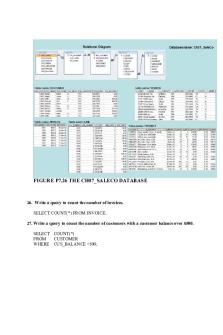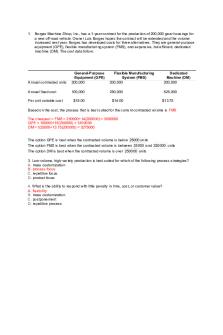CH7 review for final PDF

| Title | CH7 review for final |
|---|---|
| Author | Tim Shelton |
| Course | IT Auditing |
| Institution | California State University Northridge |
| Pages | 2 |
| File Size | 175.6 KB |
| File Type | |
| Total Downloads | 90 |
| Total Views | 171 |
Summary
CH7 review for final...
Description
CH7 computer-assisted audit tools and techniques Review questions: 1 - 5 1. What are the broad classes of input controls? Response: 1. Field . 2. Record 3. File(class answer..) a. source document controls b. data coding controls c. batch controls d. validation controls e. input error correction controls f. generalized data input systems 2. What types of errors do check digits detect? Check digits can effectively be used to determine that all of the numbers in a numeric data stream were entered. 3. Give one example of an error that could be detected by a check digit control. Response: Check digits can effectively be used to determine that all of the numbers in a numeric data stream were entered. This method involves adding up the numbers in the data stream in order to determine the check digit. Consider the following number, 789. The check digit would be: 7 + 8 + 9 = 24 = 6. If a 7, an 8, and a 9 are not entered, then chances are that the check digit will be incorrect. This method will not detect a transposition error. For example, if 879 were entered, the check digit would still be 6. 4. What are the primary objectives of a batch control? Response: The objective of batch control is to reconcile output produced by the system with the input originally entered into the system. This provides assurance that a. All records in the batch are processed. b. No records are processed more than once. c. An audit trail of transactions is created from input through processing to the output stage of the system.( so that you can test such batch transactions down the road) 5. Classify each of the following as a field, record, or file interrogation test: Field is a column, a record is a row, a file is a file… A field is part of a record and contains a single piece of data for the subject of the record;Records Data is stored in records. A record is composed of fields and contains all the data about one particular person, company, or item in a database. In this database, a record contains the data for one customer support incident report. Records appear as rows in the database table. a. Limit check ---- field, it is not a record cus it wont be a row crossing other records, like hours work, employees IDs… b. Validity check---- field, c. Version check---- file d. Missing data check-----field e. Sign check----record f. Expiration date check-----file g. Numeric-alphabetic data check ----field h. Sequence check-----record i. Zero-value check(similar to missing data check)――field j. Header label check----file k. Range check----field l. Reasonableness check----record Discussion questions: 5, 9 5. The order entry system will allow a 10 percent variation in list price. For example, an item with a list price of $1 could be sold for 90 cents or $1.10 without any system interference. The cost of the item is $3 but the cashier entered $2. Which control would detect this error? Response: Range check
9. Input validation includes field interrogation that examines the data in individual fields. List four validation tests and indicate what is checked in each. Response: Numeric-alphabetic checks look for the correct content in a field, numbers, or letters; zero-value checks determine if necessary zeros are present; limit checks verify that values are within preset limits; range checks verify the values fall within an acceptable range. Other acceptable responses include missing data checks that look for blank spaces, validity checks that compare actual values in a field against known acceptable values, and check digit controls that identify keystroke errors in key fields. Problems: 1 1. Input Validation Identify the types of input validation techniques for the following inputs to the payroll system. Briefly explain the controls provided by each of these techniques. a. The payroll system accessed the payroll file a. File Interrogation. Verify internal label to ensure the correct file is being accessed. b. New employee b. Record Interrogation. Reasonableness and sequence checks to verify the entire record. Field checks on pay rate and personal information to be entered: Validity check, missing data check, sign checks, numeric-alphabetic data check. c. Employee name c. Alphabetic check validates that letters are entered where only letters are required to be entered, e.g., employee name. d. Employee number d. Check digit to verify that the number is correct . e. Social security number e. Missing data check, numeric check, validity check. f. Rate per hour or salary f. Range check, reasonableness check sign check g. Marital status g. Missing data check ensures that no blank fields are entered where data should be present, e.g., marital status, validity check h. Number of dependents h. Reasonableness check, limit check. Missing data check. i. Cost center i, Validity check. j. Regular hours worked j. limit check, missing data check
k. Overtime hours worked k. Reasonableness checks validate that only data within a pre-specified range is entered, e.g.,
number of hours worked greater than zero and less than A transcription error is a specific type of data entry error that is commonly made by human operators or by optical character recognition (OCR) programs. batch systems are more susceptible to exposure and require a greater degree of control than real-time systems...
Similar Free PDFs

CH7 review for final
- 2 Pages

393 Review for Final
- 19 Pages

Review FOR Final - coursework
- 12 Pages

Review Sheet for Final
- 7 Pages

Final Review for Genetics
- 25 Pages

Review Questions For Final
- 4 Pages

Ch7 - Ch7
- 11 Pages

Ch7
- 4 Pages

Review Sheet for Final Exam
- 12 Pages

Review Sheet for Bio Final
- 14 Pages

Final Review for chapter c
- 4 Pages

Final Exam Review for ENGL0101
- 16 Pages

Review for Final MC solution
- 10 Pages

Final Review for CHM 2045
- 16 Pages

Final Review for ENGR 102
- 7 Pages

PM Final Review - Final Review
- 21 Pages
Popular Institutions
- Tinajero National High School - Annex
- Politeknik Caltex Riau
- Yokohama City University
- SGT University
- University of Al-Qadisiyah
- Divine Word College of Vigan
- Techniek College Rotterdam
- Universidade de Santiago
- Universiti Teknologi MARA Cawangan Johor Kampus Pasir Gudang
- Poltekkes Kemenkes Yogyakarta
- Baguio City National High School
- Colegio san marcos
- preparatoria uno
- Centro de Bachillerato Tecnológico Industrial y de Servicios No. 107
- Dalian Maritime University
- Quang Trung Secondary School
- Colegio Tecnológico en Informática
- Corporación Regional de Educación Superior
- Grupo CEDVA
- Dar Al Uloom University
- Centro de Estudios Preuniversitarios de la Universidad Nacional de Ingeniería
- 上智大学
- Aakash International School, Nuna Majara
- San Felipe Neri Catholic School
- Kang Chiao International School - New Taipei City
- Misamis Occidental National High School
- Institución Educativa Escuela Normal Juan Ladrilleros
- Kolehiyo ng Pantukan
- Batanes State College
- Instituto Continental
- Sekolah Menengah Kejuruan Kesehatan Kaltara (Tarakan)
- Colegio de La Inmaculada Concepcion - Cebu